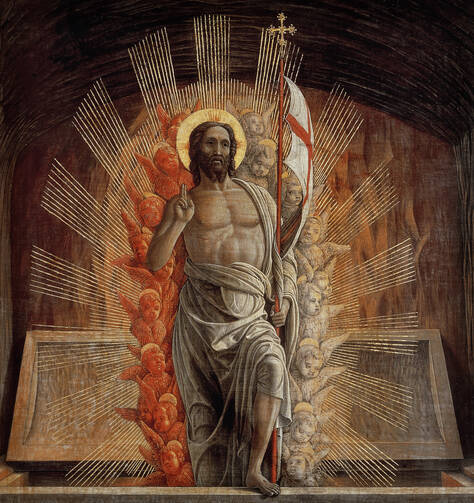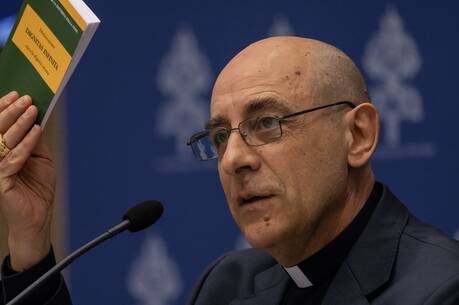So: another Easter.
And as that modern-day theologian, Seinfeld, might say, “What is the deal with Easter?”
I passed a display in a candy store window last weekend, and the sign said: “Nothing says ‘Easter’ like a chocolate bunny.”
So is that the whole deal with Easter? The bunny and the baskets and the egg hunt?
We know that those things are only part of the deal. We come together here to reflect on the holy part of the Easter deal.
We learn as children, along with the rabbit and the eggs, that Jesus rose from the dead on Easter. That Jesus rises every Easter.
I looked up the word “rise,” and the definitions are marvelous. To rise is to move from a lower position to a higher one, and Jesus, being God, certainly does that on Easter. It means to get up from lying, sitting or kneeling, and Jesus does more than that: he rises from the tomb. To rise is to ascend, levitate, climb, increase, hike, leap, skyrocket, upsurge, escalate, spring up; and if we stick with Jesus, we will do all of those things.
We may also learn as children that Jesus became one of us to bring us to the happiness of everlasting life with God when we die. We perhaps learn, as adults, that Jesus suffered and died as a fully human man to be in solidarity with us, so that we might know, in our own particular suffering on this green earth, that we are never alone.
As adults, though, we struggle with the reasons for suffering and tragedy and pain—we have all asked, in times of sorrow: why does God allow these terrible things to happen to wonderful people?—but our wisest answer is that we cannot know. We only know that Jesus knows what we’re going through, that he totally gets it; and that along with him, God does not abandon us, ever.
It occurs to me, however, that another lesson of the Easter season, what we glean from retelling and reliving the story of the passion and crucifixion and resurrection of Jesus, is that just as Jesus teaches us how to suffer and die, he also teaches us how to rise.
And I’m talking about rising before we die. Before our final rising to the next life, we rise in many smaller ways as we travel our unique road of life. The holy season of Easter reminds us each year of God’s promise to raise us up. Our yearly celebration of Easter renews us and reignites our faith and restores our hope. But maybe it is in our daily risings that we best understand God’s constant presence and grace.
We use the expression “to rise to the occasion” when someone behaves commendably and nobly, when we see the best that humanity can be. And these daily risings that I’m talking about often seem neither saintly nor glorious, but they connect us all the same to the sacred.
When we parents bite back harsh words and instead show only a calm face of love, is that not a kind of resurrection?
When we go to Subway and buy some suspicious character hanging around outside a sandwich, and offer it without cringing, we rise.
When we swallow our fear and speak up on behalf of someone who is being treated unjustly, we rise.
Anytime we put our own creature comfort second to a fellow person’s, we rise. Those corporal works of mercy, the things we do for the least among us, the ones enumerated in Matthew 25, the feeding, the sheltering, the clothing, the visiting, are all small lessons in resurrection. When we breathe a simple thank-you to God for a beautiful warm day or the last piece of pie or a child’s trust or a co-worker’s help or a spouse’s kiss or any of the thousand blessings we experience in a normal day, we rise. And with each tiny resurrection, we are transformed. How could we not be?
If we say we follow Jesus, then we must absorb all that he teaches us in his brief human incarnation, in the suffering and the celebrating, in the dying and the rising. Easter shows us that all the opposites go hand-in-hand, that they balance each other and help to define each other. We are glum Christians if we are only about the suffering: we will not inspire anyone with a sad or accusatory testimony. We are shallow, sappy Christians if we are only about the rising: if we only acclaim what my friend calls “pretty Jesus,” a testimony with no depth.
In our lives and in our faith, we fall, but we rise. We doubt, and yet we rise. We even despair, we feel abandoned, but then Jesus, usually looking like someone else, grasps our hands, pulls us up, dusts us off, and we rise.
As Maya Angelou writes:
The sun rises, the moon rises, the sea rises, the wind rises. Rise and shine, we say in greeting the morning. May the road rise to meet you, say the Irish.
Jesus rises on Easter, and we rise, too.
Let us therefore keep the risings of the ages in mind as we embrace the grace of our daily risings, and pass on the message of Easter to our children and to everyone whose lives we touch. Let us rise up. Let us embody, as Jesus incarnate teaches us, the soaring hope and sacred calling of the Resurrection.
And may you encounter at least one chocolate bunny on this day from God.
Valerie Shultz is a frequent contributor to America. This reflection was delivered on Holy Saturday at St. Paul's Episcopal Church in Bakersfield, Calif.








